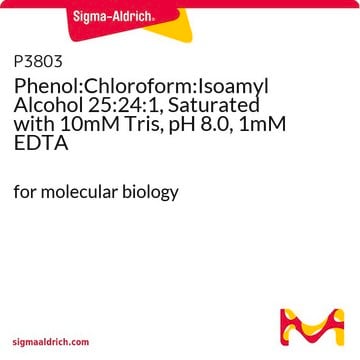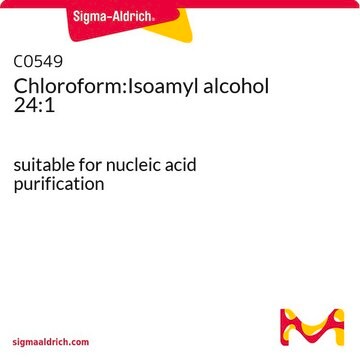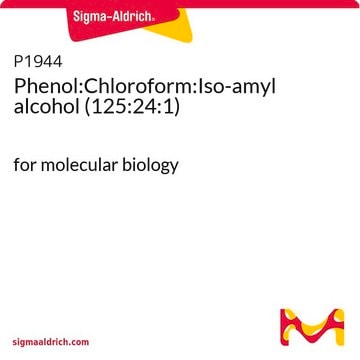P4682
Fenolo
BioReagent, Saturated with 0.01 M citrate buffer, pH 4.3 ± 0.2, for molecular biology
Sinonimo/i:
nucleic acid extraction
About This Item
Prodotti consigliati
Grado
for molecular biology
Nome Commerciale
BioReagent
Forma fisica
liquid
tecniche
RNA purification: suitable
pH
4.1-4.5 (25 °C)
Temperatura di conservazione
2-8°C
Stringa SMILE
Oc1ccccc1
InChI
1S/C6H6O/c7-6-4-2-1-3-5-6/h1-5,7H
ISWSIDIOOBJBQZ-UHFFFAOYSA-N
Informazioni sul gene
human ... GABRA1(2554)
Cerchi prodotti simili? Visita Guida al confronto tra prodotti
Descrizione generale
Applicazioni
- for the extraction of RNA by standard phenol-chloroform protocols
- in cell wall monosaccharide analysis to treat epidermal strips from the abaxial side of Commelina communisin leaves
- as a component of lysis-denaturation buffer for RNA isolation
Azioni biochim/fisiol
Prodotti correlati
Avvertenze
Danger
Indicazioni di pericolo
Classi di pericolo
Acute Tox. 3 Dermal - Acute Tox. 3 Inhalation - Acute Tox. 3 Oral - Aquatic Chronic 2 - Eye Dam. 1 - Muta. 2 - Skin Corr. 1B - STOT RE 2
Organi bersaglio
Nervous system,Kidney,Liver,Skin
Codice della classe di stoccaggio
6.1A - Combustible acute toxic Cat. 1 and 2 / very toxic hazardous materials
Classe di pericolosità dell'acqua (WGK)
WGK 2
Punto d’infiammabilità (°F)
Not applicable
Punto d’infiammabilità (°C)
Not applicable
Certificati d'analisi (COA)
Cerca il Certificati d'analisi (COA) digitando il numero di lotto/batch corrispondente. I numeri di lotto o di batch sono stampati sull'etichetta dei prodotti dopo la parola ‘Lotto’ o ‘Batch’.
Possiedi già questo prodotto?
I documenti relativi ai prodotti acquistati recentemente sono disponibili nell’Archivio dei documenti.
I clienti hanno visto anche
Il team dei nostri ricercatori vanta grande esperienza in tutte le aree della ricerca quali Life Science, scienza dei materiali, sintesi chimica, cromatografia, discipline analitiche, ecc..
Contatta l'Assistenza Tecnica.








